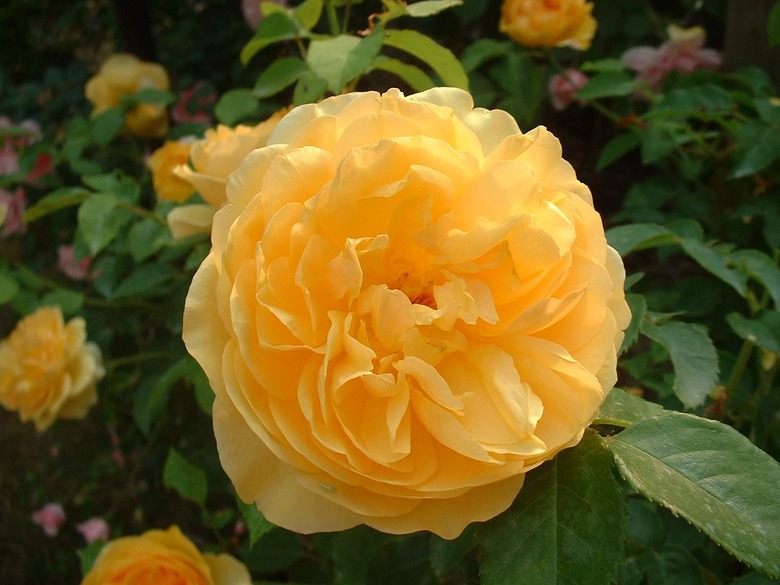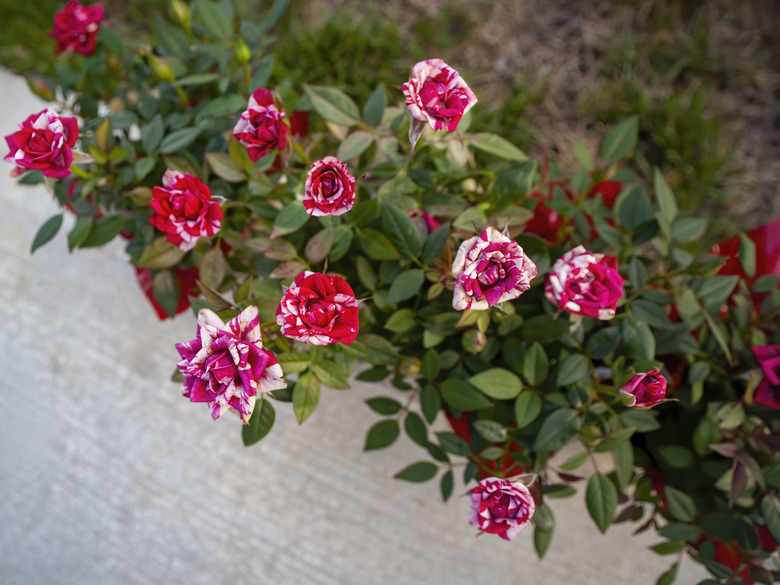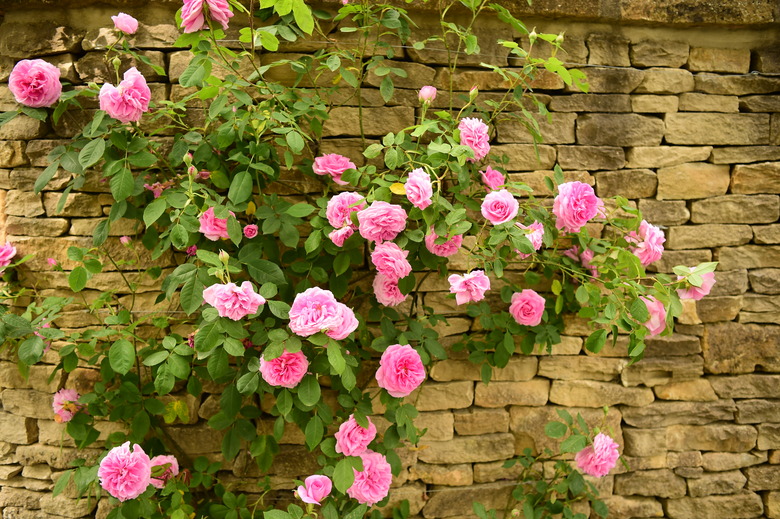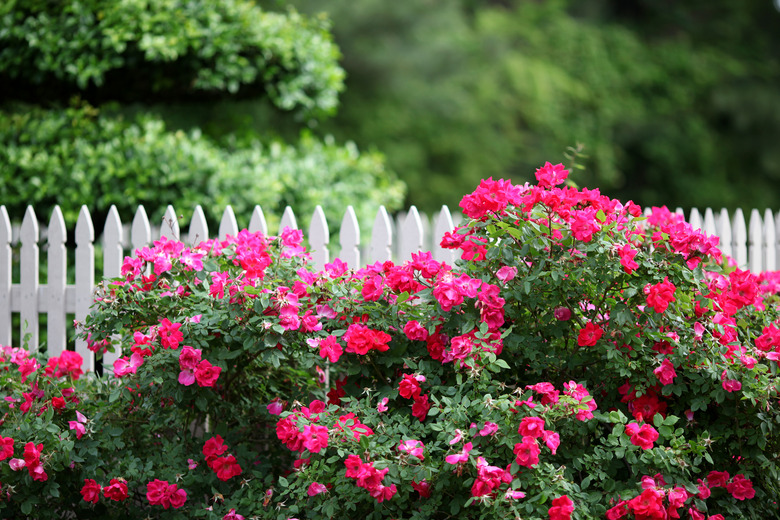The 11 Types Of Roses — And How To Choose A Rose Plant
We may receive a commission on purchases made from links.
When you think of virtually any of the types of roses in existence, you're most likely visualizing some variety of the modern garden rose. This type of rose, relatively young compared to its cousins, is the kind most often found in garden centers, florist shops and flower beds. From climbing roses to hybrid tea roses, choosing the best type for your garden depends on your ultimate plans for the plant. If you enjoy cut roses, for instance, a hybrid tea rose is a good option, while smaller plants, such as the polyantha, are good for adding pops of color in front of tall shrubs or along walkways. Luckily, there are many different types of roses for every gardener's taste and yard space, and here's our list to help you choose the best rose plants for your landscape.
1. Hybrid Tea Rose
1. Hybrid Tea Rose
The tall stems of the hybrid tea rose make this variety quite popular for floral arrangements and are often what shows up when someone orders a bouquet of long-stemmed roses. Growing them requires a bit more care than other types of roses, as they aren't as hardy as other types, such as the shrub rose. On the other hand, numerous hybrid tea roses exist, and new cultivars are introduced on a regular basis, so they could be of interest to the experienced rose gardener on the lookout for something new. This type of hybrid rose first came about in France in the late 1860s and is one of the most popular rose types today.
A hybrid tea rose generally has between 30 and 50 petals, with a somewhat pointed center as the bloom begins to open. The flowers are quite fragrant in many varieties, which is another reason they're popular with florists. Though they often grow up to 5 feet tall, some reach up to 8 feet high, which makes them best suited for the middle or back of a flower bed. Many hybrid tea roses aren't all that winter hardy and may only grow as perennials in some USDA plant hardiness zones, such as 7 through 10. Before purchasing a hybrid tea rose plant online, make sure the variety is suitable for your area.
If you live in an area with freezing winters, add a conical mound of soil 6 to 8 inches deep around the plant before the first frost. Cut back any diseased or unhealthy areas of the plant using sanitized pruners. Trim tall stalks down to 2 feet high. If the plant needs further pruning before spring growth begins, do so in late winter or early spring once the threat of serious freeze has passed.
2. The Miniature Rose
2. The Miniature Rose
Miniature roses, such as the potted varieties sold in large grocery stores, are most often a tiny form of the hybrid tea rose, although some are miniature grandiflora roses. The flowers, stems and entire plant are quite a bit smaller than just about all other types of roses, generally staying less than 18 inches high with some exceptions. They're typically sold in small pots as houseplants even though they'll do better outside in larger containers or in flower beds as border plants. They generally offer continuous blooms for about three weeks. Like other types of roses, these are available in quite a few colors.
If kept indoors, place them in direct sunlight, such as in a south-facing window away from drafts or extreme heat. If the plant stays in a container but you keep it outdoors during warm weather, bring it in before the ground freezes. In the ground, many miniature roses survive the winter, especially with a mound of fresh soil or mulch around the stems. Miniature hybrid tea roses are more hardy than their larger cousins.
3. The Floribunda Rose
3. The Floribunda Rose
Floribundas first came on the scene in the late 20th century and are named for the abundant blooms they produce. A hybrid between the polyantha and the tea rose, the floribunda offers more blooms than tea roses, with flowers that look a lot like tea roses. Unlike tea roses, floribunda varieties are usually a lot shorter and more shrubby in appearance. The clustered blooms open at staggered times from late spring until fall, making them a great choice for long-lasting color in the landscape. These range from pink to orange or even a deep red, white or purple.
The floribunda is much easier to care for and is nearly maintenance-free compared to the average tea rose. These disease-resistant roses are often used in public spaces thanks to their minimal care requirements. For best results, plant them in an area of full sun with well-draining soil.
4. Grandiflora Hybrid Roses
4. Grandiflora Hybrid Roses
The grandiflora is a cross between a floribunda and a hybrid tea rose. Its large blooms usually grow in clusters atop long stems rather than single blooms per stem. These are another popular choice among those who enjoy a vase of cut flowers from time to time. They generally grow taller than the floribunda, with stems reaching 6 or 7 feet high, so they're best toward the back of a flower bed or where they won't block your view of your other flowering plants.
The height varies depending on the particular cultivar, so read the specifics before purchasing to choose an appropriate location. The shrubs themselves are larger and more upright than the hybrid tea rose. Although these are hardier and more disease-resistant than hybrid tea roses, they're not as common.
5. The Polyantha Rose
5. The Polyantha Rose
This type of rose is a compact shrubby plant with clusters of abundant small blooms, with flowers generally about 1 inch across. They're hardy, require little maintenance and bloom from spring to fall, so they're a nice choice even for the novice gardener or the flower bed that is short on space. They range from white to pink to red and work well in containers too. They also grow well in a series to make a nice flowering hedge display. They're usually quite resistant to pests and disease and have no specific care requirements, setting them apart from other roses.
Some varieties are nearly thornless, while other varieties can be guided to grow like climbing roses; one or two even have both traits. Climbing types can grow up to 10 feet tall. Depending on the cultivar, the polyantha rose could be a nice choice with a trellis along a garden wall or, in the case of relatively thorn-free cultivars, used near children's play areas in the backyard.
6. The Climbing Rose
6. The Climbing Rose
Though these technically don't climb the way some ivies and vines might, the climbing rose grows on a sturdy vertical cane that can be trained to grow along a trellis or other structure by tying the canes to the upright supports. These are not different than other types, such as grandiflora, but rather fit a description of any type of rose that can be trained to grow vertically. Some grow up to 15 feet high. Most climbing roses produce large blooms, although the blooms are most numerous if the plant's canes grow horizontally rather than being guided to grow vertically. Some climbing roses bloom more than once per season.
Like other roses, climbing roses prefer plenty of sun and a well-draining soil. Care is essentially the same as with other roses other than the training part. If you want the rose to grow vertically, it needs plenty of airflow to stay healthy. This is why a trellis is a better choice than trying to get the plant to grow directly against bricks, for instance.
Purchase a climbing rose as a bareroot plant to place in the ground in late winter once the ground can be worked. Roses don't cling or intertwine themselves with nearby structures the way vines do, so you'll have to guide the plant by using small bits of loose twine, for instance. For the most blooms, guide the growing twigs to spread out horizontally a little along a trellis or fence.
Keep pruning to a minimum the first two years, as most blooms grow on second-year growth. Prune after three or four years, removing small, twiggy growth or old, underproducing canes. Fertilize regularly with a balanced fertilizer that's specifically formulated for roses.
7. The Rambling Rose
7. The Rambling Rose
Like the climbing rose, the rambling rose blooms on old growth. Some use the terms "climbing" and "rambling" interchangeably, but there is a slight difference between the two. Most rambling roses bloom just once per growing season, while most climbers bloom more than once. Ramblers often produce more blooms than a similar climbing rose and somewhat smaller blooms than a climbing rose.
Like climbing roses, ramblers can be trained to follow trellises and similar structures. This works best in fall with young, flexible canes. They can even be trained to curl around stakes and fence structures.
8. The Ground Cover Rose
8. The Ground Cover Rose
This rose, also known as a landscape rose, sprawls out a bit and is usually wider than it is tall, although some still reach 3 feet in height. They bloom from spring to fall and may have single or double blooms. These low-maintenance plants are available in just about any common rose color and are fragrant while being resistant to pests and diseases. Ground cover roses are great for first-time rose growers and can be used to fill space in a flower bed or used in a series along a property border for a colorful display that won't block views.
Ground cover roses work well on steep slopes that are otherwise difficult to maintain. Some versions work well in wide containers with twigs of blooms gently arcing downward along the sides of the container as the plant grows. The Flower Carpet ground cover rose series (e.g., Rosa 'Flower Carpet Red' and R. 'Flower Cart Appleblossom') is especially popular thanks to minimal maintenance requirements. Some ground cover roses are also miniature roses.
9. Shrub Types of Roses
9. Shrub Types of Roses
Shrub roses are designed to be hardy and generally low maintenance. This designation fits numerous rose varieties that don't fall into other classifications. Many, such as some David Austin roses, started out as a hybrid between modern and wild roses. Shrub roses may be either old or modern roses, so read the details on your specific plant before purchasing if the designation matters to you. Since this classification covers so many roses, the colors, flower size and plant size vary greatly from one to the next.
Generally, any rose that could be considered a bush or hedge is a shrub rose. Though they are profuse bloomers, they do not require deadheading. Shrub roses are among the easiest to care for, and though they don't require it, cutting them back to 1 foot above ground in late winter or early spring before growth begins helps maintain a manageable size and may increase the number of blooms.
10. David Austin English Roses
10. David Austin English Roses
David Austin roses, also known as English roses, are bred by the company David Austin Roses, named for the founder that started cross-breeding old garden and modern roses in the 1950s. The company still breeds numerous varieties of roses in its family rose gardens in Shropshire, England.
Through intensive cross-breeding and hand-pollination practices, the company has created a vast array of hybrid roses, growing them in its gardens for years before selecting a few of the best hybrids to sell on the market based on beauty and plant health. More than 200 cultivars exist, many of which bloom repeatedly and have an abundance of petals and a fairly strong fragrance compared to other modern roses.
David Austin roses may be shrubs, ramblers, climbers or even rose "trees" that feature a single, solid "trunk" with shrubby rose bush growth on top. Care varies a bit depending on the type.
11. English Tree Roses
11. English Tree Roses
Tree roses generally thrive in zones 4-11 and prefer partial to full sun depending on the variety, and they're not overly picky about soil conditions, although a well-draining soil is always a good option. Tree roses are great along walkways, where their blooms and fragrance can be enjoyed when walking past them. They're also stunning in pairs on either side of an entryway.
The David Austin varieties in particular emit pleasing fruity or tealike fragrances and display blooms almost continually. They grow about 3 feet high and need to be staked until they are well-established. As with other types of roses, the many roses within this category may vary in overall petal and plant size as well as fragrance.
Choosing the Healthiest Roses
Choosing the Healthiest Roses
For best results when rose shopping, choose plants from local growers who are well-versed in rose care; this way, you can see the plants, and the growers are available to offer tips and recommendations based on your flower bed location. Online rose specialists are another option, especially if you wish to purchase a special variety, such as those bred by David Austin. Many growers sell bare-root roses, which look like a group of twigs but are actually living rose plants dug up in winter while dormant. Planting them before the spring growing season begins is a good way to let a bare-root rose acclimate to its surroundings.
Bare-root roses are sold based on a grading system used by the American Nursery & Landscape Association. A grade #1, which is the best grade, means the plant has at least three healthy twigs that are 5/16 inch in diameter or greater. The other grades, #1.5 and #2, do not quite meet the requirements in size or number of healthy canes, so while they are generally healthy, they may take longer to reach a large size.
The canes on bare-root roses or any roses available for purchase should look healthy, alive and not shriveled. Roots should also be healthy and neither shriveled nor mushy. In some cases, roses for sale have a waxy coating on their twigs, which may cause a delay in the plants' ability to develop buds.



